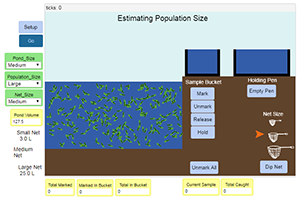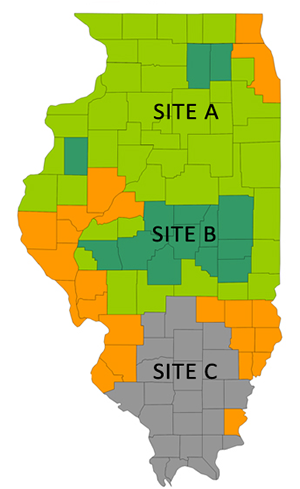Estimating Population Size - a NetLogo Simulation

Go to biol.co/popsize
The simulator shows tadpoles in a pond with controls that allow you to change the pond size, population size, and the size of the net used to capture the tadpoles.
Simulation 1 - Medium Sized Pond, Large Population, Medium Net
1. Use the net to capture (use the dip net button) a sample of tadpoles. 
2. Mark 10 of the captured tadpoles. 
3. Release the marked tadpoles back into the pond. These are the only tadpoles that will be marked. 
4. Use the medium net size to capture another five more samples and record the number marked in each of those recaptures (do not mark). Release the tadpoles between samples. 
Sample Bucket 1 |
Sample Bucket 2 |
Sample Bucket 3 |
Sample Bucket 4 |
Sample Bucket 5 |
Totals |
|
Number Marked |
||||||
Total in Bucket |
5. Use the equation below to estimate the total number of tadpoles in your population. Show your work!

6. Reset the simulation and repeat the experiment, but this time, initially mark 20 tadpoles.
Sample Bucket 1 |
Sample Bucket 2 |
Sample Bucket 3 |
Sample Bucket 4 |
Sample Bucket 5 |
Totals |
|
Number Marked |
||||||
Total in Bucket |
7. Use the equation to estimate the population size again, you will need to change the number marked to 20. Show work below.
8. Compare your two estimates to the real number of tadpoles in the pond. How does changing the number of initial tags alter the accuracy of the results? Should you tag more tadpoles or less?
Simulation 2 - Medium Sized Pond, Medium Population, Medium Net

Next you will estimate a larger population within the pond. Reset the simulation an alter the controls so that you have a medium sized population in a medium sized pond, using a medium sized net. Tag 10 tadpoles to start with.
Sample Bucket 1 |
Sample Bucket 2 |
Sample Bucket 3 |
Sample Bucket 4 |
Sample Bucket 5 |
Totals |
|
Number Marked |
||||||
Total in Bucket |
9. Use the equation to estimate the total number of tadpoles in your population. Show your work!
10. Repeat this experiment (don’t forget to reset), but compare how your estimate changes if you take more samples.
Sample Bucket 1 |
Sample Bucket 2 |
Sample Bucket 3 |
Sample Bucket 4 |
Sample Bucket 5 |
Sample Bucket 6 |
Sample Bucket 7 |
Sample Bucket 8 |
Totals |
|
Number Marked |
|||||||||
Total in Bucket |
Use the equation to estimate the number of tadpoles in your large population. Show work!
11. Compare your two estimates to the real number of tadpoles in the pond. How does changing the number of samples alter the accuracy of the results? Should you take more samples or less?
12. Application

A state agency wants to release endangered hawks but needs to determine the best site for their release. The state would like to know how many rabbits are in each area to determine which area has the largest prey population.
Create a plan to determine how many rabbits are in each area to determine which site is the best location. Your plan should include specific information on how many animals will be tagged and how many samples should be taken to get the most accurate results. Use your simulation data to help you develop this plan.
Write your plan below, you an describe it in steps and even include sketches to illustrate your plan.
Other Resources on Populations
Google Slides and Notes on Populations
Estimating Population Size – use bags filled with “animals” to mark and recapture and estimate the population size in the bag
Case Study – Loggerhead Turtles and Population Models – explore the number of eggs hatched and survivorship
Ecology Case Study – The Wolves of Isle Royale – population decline and reintroduction of wolves

